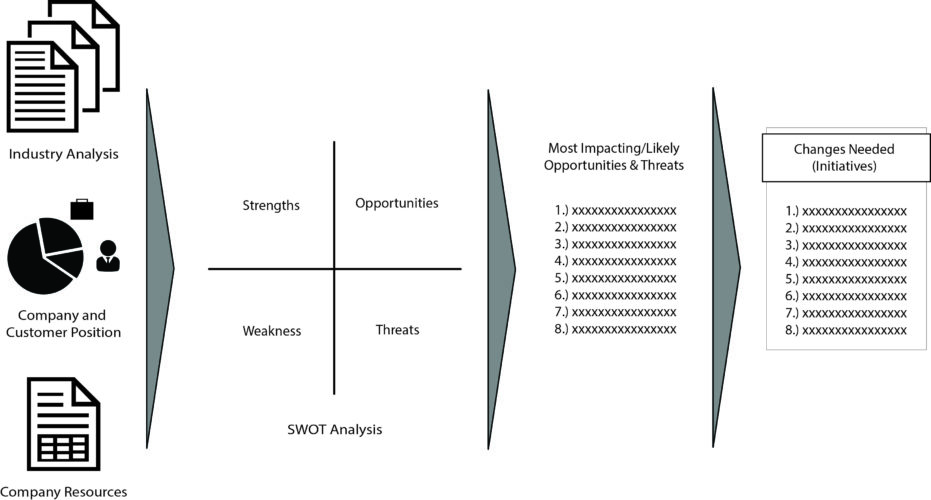March 13, 2019 | Project, Program, Portfolio Management
In our last blog, we discussed a very simple approach to establishing Goals and Priorities. The simple approach we outlined relied heavily on the individual knowledge, ability, and instincts of a company’s leadership team to identify “Big Rock” initiatives from Ideation through Elaboration and Prioritization. In this post, we are going to discuss improvements that can be made to drive more analytical and quantitative elements into the process.
AN ANALYTICAL APPROACH TO ESTABLISHING GOALS & PRIORITIES:
STEP ONE: IDEATION
One good approach to identifying potential initiatives is to start from market data and industry analysis to form an understanding of trends/changes in the demand, technology, pricing, and delivery mechanisms that could impact your company. Once these are understood, perform a SWOT (Strengths, Weaknesses, Opportunities, and Threats) analysis to assess your company’s (and customers’) position relative to the broader trends. After completing the SWOT, highlight the key Opportunities and Threats (those that have the greatest impact and are likely to occur) and identify specific changes that are needed to address these items. This will be the list of initiatives that you carry into the Elaboration step.
STEP TWO: ELABORATION
Creating a lightweight Business Case for each initiative can frame the benefits, investments and risks in a consistent manner, using common inputs and assumptions. Doing so will make “apples-to-apples” comparison of competing initiatives much easier in the Prioritization step. Ideally, every bit of analysis effort is contributing necessary intelligence to the Prioritization step. Some suggestions regarding scoping and inputs for lightweight business case construction:
|
SCOPE OF ANALYSIS FOR A LIGHTWEIGHT BUSINESS CASE: Benefit Analysis: Why should this initiative be pursued? Will it generate new revenue or cost savings (or cost avoidance)? Is this initiative needed to address legal issues or regulatory compliance—if so, what is the impact of non-compliance? Is this initiative aligned with the company’s broader strategic direction? Investment Required: What resources (money, skills, time) are required to successfully implement this initiative? How will these resources be consumed (front weighted vs back weighted vs evenly distributed)? What percentage of the costs can be capitalized? Were these costs/resources budgeted? Does this initiative make use-of or de-value other assets? What are the long term/on-going costs? Risk Analysis: What is the confidence level of the benefit and investment analysis—what evidence or experience supports these claims? Are new vendors or technologies required? Is the business prepared for changes required-for or resulting-from the initiative? How sensitive is the initiative to shifts leadership, schedule, demand, resource availability, etc.? What affect does this initiative have on the company’s position in the market? |
|
KEY INPUTS TO SHARE PRIOR TO CONSTRUCTING LIGHTWEIGHT BUSINESS CASES: Strategic Initiatives: If already defined, what are the corporate strategic initiatives? Planning Horizon: For revenue/cost projections and NPV analysis, what time horizon should be used (note: this will likely vary based on initiative type). Assumed Discount Rate: What discount rate should be used for calculating future costs and benefits when conducting NPV and IRR analysis? Templates/Formulas: To simplify and drive more consistency, templates should be provided that mask the complexity of NPV & IRR analysis. |
STEP THREE: PRIORITIZATION
During the Ideation and Elaboration steps, each prospective initiative is analyzed in isolation from competing initiatives, on-going operations, and other in-flight activities. In the Prioritization step, the initiatives are compared to each other and viewed in the context of other business activities. This contextual analysis is the reason why Prioritization is not simply a stack rank of the initiatives based on their IRR or NPV metrics. The identification of the most lucrative initiatives (based on IRR and NPV) is a useful input, but that is only where Prioritization efforts begin. Once those high-value initiatives are identified, consideration needs to be given to other factors such as:
|
Therefore, the goal of the Prioritization step is to maximize the value that can be delivered to the company given its current needs and resource constraints at a managed risk-level. This generally is a negotiation that requires the insights and buy-in of all departments/teams involved in enabling, receiving, and supporting the changes that the initiative will deliver.
Although we are presenting Prioritization as the third step in a sequence, the best practice is to review and groom in-flight and new initiatives’ prioritization on a regular, recurring basis. The results of the Prioritization activity should be shared across the organization and, to the degree possible, with vendor partners. Doing so will make it possible for all teams to maintain focus on the most critical initiatives even as business and market conditions evolve.
RESULTS
The final output will be a prioritized set of initiatives—each designed around a specific business need and prioritized based on benefit, investment and risk. Unlike the “Simple Approach” in our last blog, the activities in Ideation/Analysis/Prioritization steps above do not rely on the knowledge of a few leaders and can be delegated to a broader set of team members. This means that the process described above is scalable and can be expanded beyond “Big Rock” initiatives and may be broadly applied to all proposed initiatives.
For more information on how Lake Shore Associates can help you with your project and change management needs, visit www.lakeshore.is.





